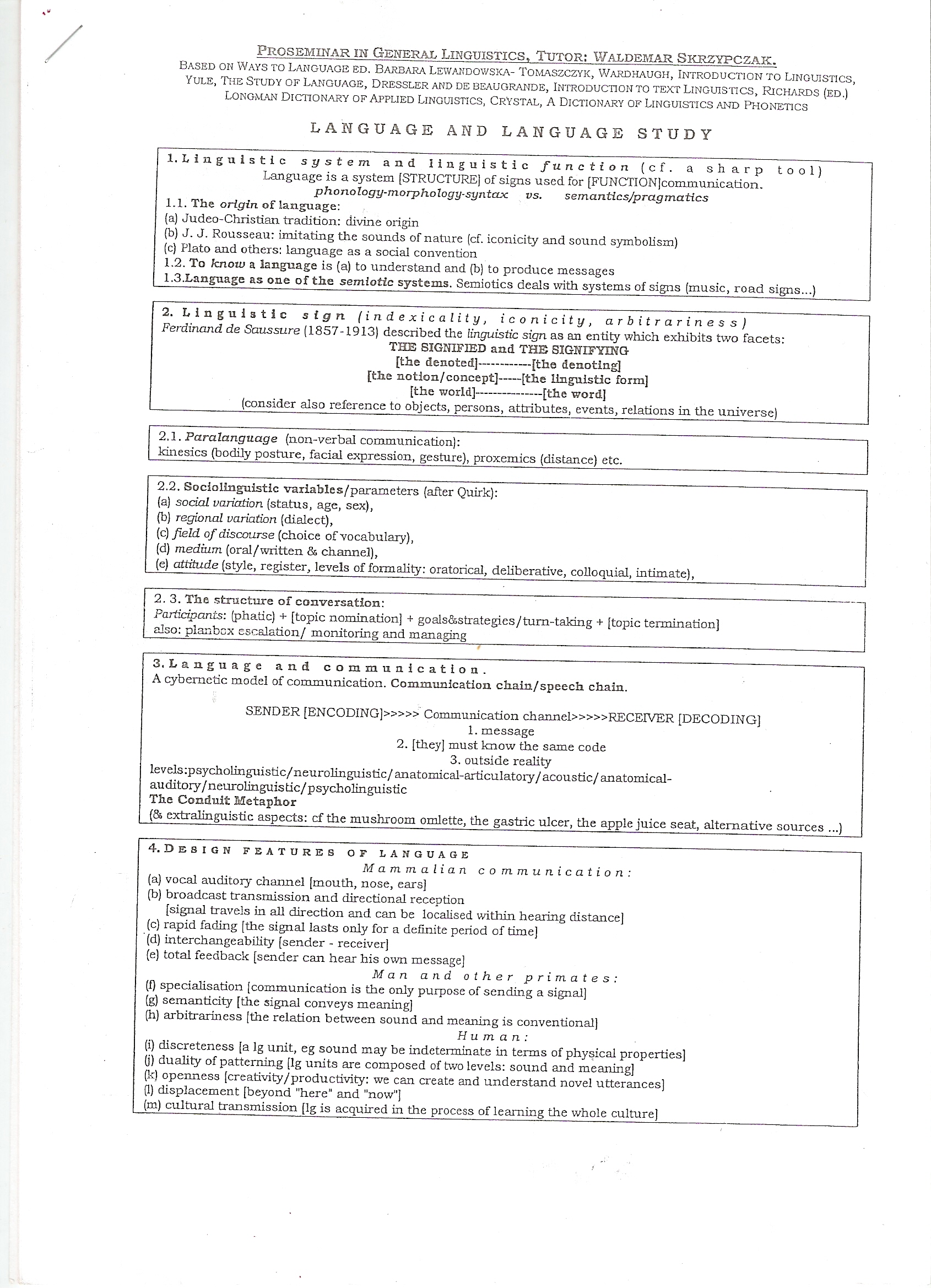lingwistyka 1

PROSEMINAR IN GENERAL LINGUISTICS, TUTOR? WALDEMAR SKRZYPCZAK.
Based on Ways to Language ed. Barbara Lewandowska- Tomaszczyk, Wardhaugh, Introduction to Linguistics, Yule, The Study of Language, Dressler and de beaugrande, Introduction to text Linguistics, Richards (ed.)
LONGMAN DlCTIONARY OF APPLIED LINGUISTICS, CRYSTAL, A DlCTIONARY OF LINGUISTICS AND PHONETICS
LANGUAGE AND LANGUAGE STUDY
1. Lingulstic system and linguistic function (cf. a Sharp tooł) Language is a system [STRUCTURE] of signs used for (FUNCTION)communication. phonology-morphology-syntcoc vs. semantics/pragmatics
1.1. The origin of language:
(a) Judeo-Christian tradition: divine origin
(b) J. J. Rousseau: iroitating the sounds of naturę (cf. iconicity and sound symbolism)
(c) Plato and others: language as a social convention
1.2. To know a language is (a) to understand and (b) to produce messages
1.3. Language as one of the semiotic systems. Semiotics deals with systems of signs (musie, road signs...)
2. Lingulstic s i g n (i n d e xi c ality, iconicity, arbitrariness) Ferdinand de Saussure (1857-1913) described the linguistic sign as an entity which exhibits two facets:
THE SIGNIFIED and THE SIGMTFYING
[the denoted]----------[the denotłng]
[the notion/concept]-----[the linguistic form]
[the world]---------[the word]
_(consider also reference to objects, persons, attributes, events, relations in the universe)
2.1. Paralanguage (aon-verbal communication):
Mnesics (bodily posturę, facial expxession, gesture), proxemics (distance) etc.
2.2. Sociollnguistlc vaxiables/pararaeters (after Quirk):
(a) social variation (status, age, sex),
(b) regional uariation (dialect),
(c) field of discourse (choice of vocabulary),
(d) medium (oral/written & channel),
(e) attitude (style, register, lewels of formality: oratorical, deliberative, colloguial, intimate), 2.3. The structure of conversatlon:
Participants: (phatic) + [topie nomination] + goals&strategies/tum-taking + (topie tennination] also: planbcx escalation/ monitoring and managing
3. Language and communication.
A cybemetic model of communication. Communication chain/speech chain.
SENDER [ENCODING]»»> Communication channel»>»RECEIVER [DECODING]
1. message
2. [they] must know the same codę 3. outside reality
levels:psycholinguistic/neurolinguistic/anatomical-articulatory/acoustic/anatomical-auditory/neurolinguistic/psycholinguistic The Conduit Metaphor
(& extralinguistic aspects: cf the mushroom omlette, the gastric uleer, the apple juice seat, altemative sources ...)
4. Design features of language
Mammalian communication:
(a) vocal auditory channel [mouth, nose, ears]
(b) broadcast transmission and directional reception
[signal travels in all direction and can be łocalised within hearing distance]
(c) rapid fading [the signal lasts only for a definite period of time]
(d) interchangeability [sender - receiver]
(e) total feedback [sender can hear his own message]
M a n and o t h e r primates:
(f) specialisation [communication is the only purpose of sending a signal]
(g) semanticity [the signal conveys meaning]
(h) arbitrariness [the relation between sound and meaning is conventional]
Humań:
(i) discreteness [a lg unit, eg sound may be indeterminate in terms of physical properties]
(j) duality of patteming [lg units are composed of two levels: sound and meaning]
(k) openness [creativity/productivity: we can create and understand novel utterances]
(l) displacement [beyond "here1* and "now"]
(m) cultural transmission [lg is acguired in the process of leaming the whole culture]
Wyszukiwarka
Podobne podstrony:
lingwistyka 1 PROSEMINAR IN GENERAL LINGUISTICS, TUTOR? WALDEMAR SKRZYPCZAK. Based on Ways to Langua
lingwistyka 1 PROSEMINAR IN GENERAL LINGUISTICS, TUTOR? WALDEMAR SKRZYPCZAK. Based on Ways to Langua
cover2 R.L DIONE writes: "I present the materiał in this book, not as a theory based on some so
fig 6 1 e Figurę 6-1 Hospitalizations for eating disorders1 in generałhospitals per 100,000 by age g
fig 6 2 e Figurę 6-2 Hospitalizations for eating disorders in generał hospitals per 100,000 by contr
IT 2 Services IT Stations 20 ©ss Signal station in generał t Sig Sta f Sig
Synergy as a lalue Generator in Tourism 15 Almost a half of the respondents pointed to the lack of s
20947 system 87 87The Rubbing Exercises General Remarks 1 have ten com pobite rubbing exercises, to
© In generał, re- developing the area could bring some profits, not only economic, to city of Piacen
Czas. Stomatol., U. Kaczmarek i in. in generał dental pracice. Acta Odont Scand 1999, 57, 5: 257-262
References [1] Bickel, B. (1998), Review article: converbs in cross-linguistc perspective. Linguisti
Picture 7 the following scheme shows (left) the principle of the wire-line drilling system in genera
dpp36 General Weight Lifting NE ot the lirst things to arrange is a suitable place in which to pract
scan0031 4 18 MICHAEL COX 1.2.3 Solvating extractants In generał a soWating extractant tends to be r
ScannedImage 31 EINFUHRUNG IN DIE LINGUISTIK EXAMlNATIONSFRAGEN SELBSTSTANDIGE LEKTURE 1. Der
więcej podobnych podstron